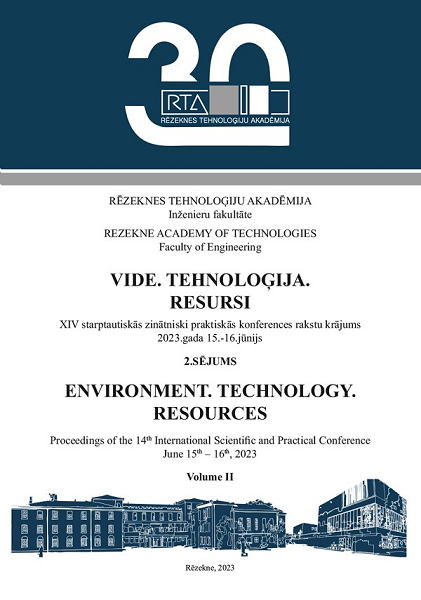ARCHITECTURE AND CONSTRUCTION STUDENTS' PERCEPTION OF “TECHNICAL DRAWING” AND “DESCRIPTIVE GEOMETRY" DISCIPLINE CONTENT
DOI:
https://doi.org/10.17770/etr2023vol2.7207Keywords:
technical drawing, descriptive geometry, graphic work, perception of the material, interest in work, complexity of performing, usefulness for the professionAbstract
The present paper highlights the results of pedagogical research conducted at the Architectural Department in the Kamianets-Podilskyi Professional College of Construction, Architecture and Design. The study considers the vocational pre-higher education students’ perceptions of various graphic works in drawing and descriptive geometry in the context of graphic work features, and understanding the significance of drawing works for the formation of a future specialist in the construction industry. Students were suggested to fill in the forms with a list of the curriculum topics and give grades according to three criteria: usefulness for the future profession, the complexity of the graphic work and the engagement in performing the task.
Research results provide problem-solving solutions related to teaching methodology of such disciplines as "Technical Drawings", "Drawings and Basics of Descriptive Geometry" and "Descriptive geometry".
Based on research findings, the recommendations concerning teaching and increasing interest in educational material can be made. It has been found that certain topics do not arouse much interest in students, so we recommend improving students' motivation in the classroom by employing engaging tasks, taking into account the peculiarities of perception and attention when studying these topics. The topics that are difficult to master according to students' responses require more hours for studying, and the topics that students consider least useful should be reviewed, reformatted, or even excluded from the program.
References
Standard of higher education of the first (bachelor) level of the field of knowledge 19 "Architecture and construction", specialty 191 "Architecture and urban planning". Approval on Ministry of Defense of Ukraine dated June 16, 2020 No. 808.
I.I. Kravchenko. The role of drawing in the educational process. Continuous system of education "school-university". Innovations and prospects. Minsk: BNTU, 2018, pp. 155-157.
E.I. Ruziev. Methodological foundations of teaching construction drawing at the IAP of pedagogical universities. 1990.
L.I. Suprun. Students' opinion about descriptive geometry. Kazan science. Collection of scientific articles №5. Kazan: 2011. pp.94-97
L.I. Suprun Formation of a culture of thinking of bachelors of architecture in teaching descriptive geometry. International Journal of Applied and Fundamental Research No. 11, 2013. pp. 92-95.
S. Yermakov, T. Hutsol, V. Devin. Effectiveness of cognitive digressions in classes of general technical disciplines in institutions of higher education of agro-technical direction. Engineering for rural development. 2022. Pp.460-465 https://doi.org/10.22616/ERDev.2022.21.TF154
I.S. Goliyad. Activation of students' educational activities in drawing classes by means of graphic tasks. Diss. Ph.D. ped. Sciences: 13.00.02 National Ped. University named after M. P. Drahomanov. Kyiv, 2005. Available: http://enpuir.npu.edu.ua/handle/123456789/5992
I. Bobrovska, L. Hrytsenko. Methodical aspects of teaching drawing in vocational and technical education institutions. Ukrainian professional education. 2019. No. 6. Pp.106-111
S. Yermakov, T. Hutsol, S. Glowacki, V. Hulevskyi, V. Pylypenko. Primary Assessment of the Degree of Torrefaction of Biomass Agricultural Crops. Environment. Technologies. Resources. 2021. pp.264-267. https://doi.org/10.17770/etr2021vol1.6597
S. Yermakov, T. Hutsol, A. Rozkosz, S. Glowacki, S. Slobodian. Evaluation of Effective Parameters Of Biomass Heat Treatment in Processing for Solid Fuel. Engineering for Rural Development. 2021. https://doi.org/10.22616/ERDev.2021.20.TF241
V.S. Lyulka, N.O. Bondar. Educational and methodological recommendations for the course "Methodology of teaching drawing": for students of specialty 6.010100 "Pedagogy and methodology of secondary education. Labor. Chernihiv: ChDPU, 2009. 84 p.
S.V. McLaren. Exploring perceptions and attitudes towards the teaching and learning of manual technical drawing in the digital age. Int J Technol Des Educ 18, 2008. Pp. 167–188. https://doi.org/10.1007/s10798-006-9020-2
H. Haapasalo. Creative Computer aided architectural design—an internal approach to the design process. Academic Dissertation presented to Faculty of Technology, University of Oulu, Finland, Oulun yliopisto (2000). Available: http://herkules.oulu.fi/isbn9514257545/
V. Ivanyshyn, S. Yermakov , T. Ishchenko. Calculation algorithm for the dynamic coefficient of vibro-viscosity and other properties of energy willow cuttings movement in terms of their unloading from the tanker. Renewable Energy Sources, vol. 154, E3S Web of Conferences. 2020, pp. 04005, https://doi:10.1051/e3sconf/202015404005 .
C. Leopold, R. Gorska, S. Sorby. International experiences in developing the spatial visualization abilities of engineering students. Journal for Geometry and Graphics, 5(1), 2001. Pp. 81– 91.
S. Olkun. Making connections: Improving spatial abilities with engineering drawing abilities. International Journal of Mathematics Teaching and Learning, 1–10. 2003. Available: http://www.cimt.plymouth.ac.uk/journal/sinanolkun.pdf
K. Ellis, D. Ritchie, A. Solar-Lezama, J. Tenenbaum. Learning to infer graphics programs from hand-drawn images. Advances in Neural Information Processing Systems. 2018. pp. 6059–6068.
E.N. Elom. Effective Teaching and Learning in Technical Colleges: Challenges of Technical Drawing. Journal of Educational Policy and Entrepreneurial Research, 1(1), 2014. Pp.76-86.



